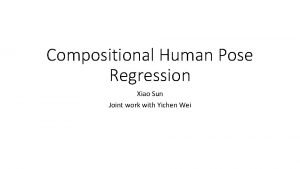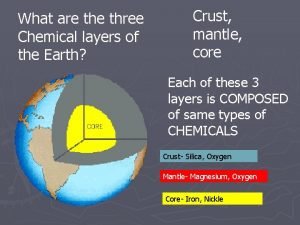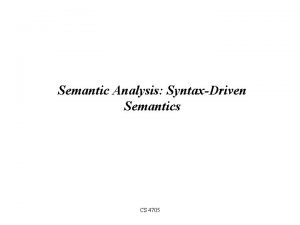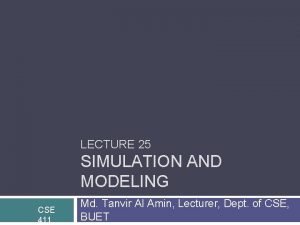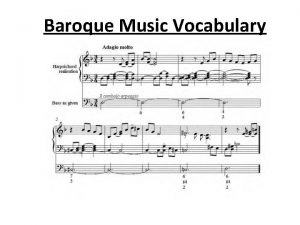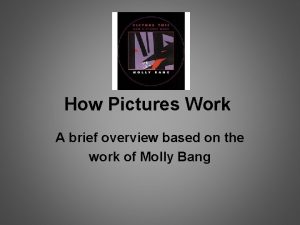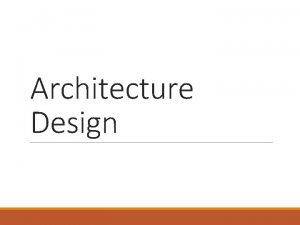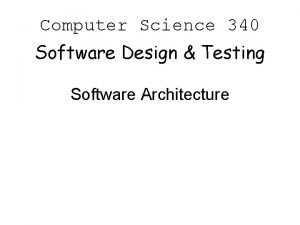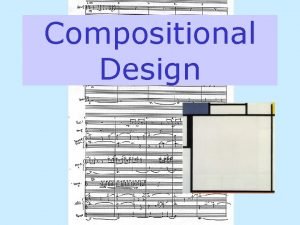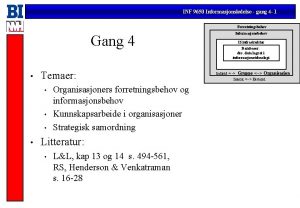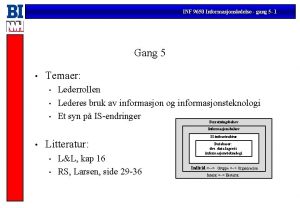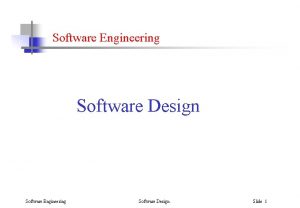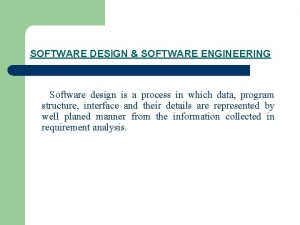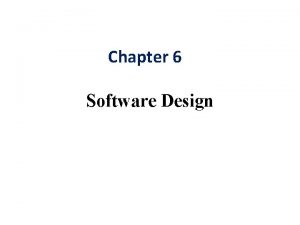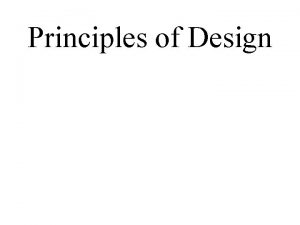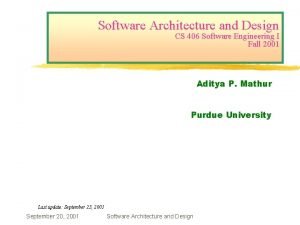Software Engineering and Architecture Compositional Design Principles Gang








































- Slides: 40

Software Engineering and Architecture Compositional Design Principles

Gang of Four (Go. F) Erich Gamma, Richard Helm Ralph Johnson & John Vlissides Design Patterns – Elements of Reusable Object-Oriented Software Addison-Wesley, 1995. (As CD, 1998) First systematic software pattern description. CS@AU Henrik Bærbak Christensen 2

The most important chapter • Section 1. 6 of Go. F has a section called: • How design patterns solve design problems • This section is the gold nugget section • It ties the patterns to the underlying coding principles that delivers the real power. CS@AU Henrik Bærbak Christensen 3

Compositional Design Principles CS@AU Henrik Bærbak Christensen 4

As the 3 -1 -2 process CS@AU Henrik Bærbak Christensen 5

First Principle CS@AU Henrik Bærbak Christensen 6

Go. F’s 1 st principle • Program to an interface, not an implementation • In other words • Assume only the role • (the responsibilities+protocol) • … and never allow yourself to be coupled to implementation details and concrete behavior CS@AU Henrik Bærbak Christensen 7

First Principle • Program to an interface because – You only collaborate with the role – not an individual object – You are free to use any service provider class! – You do not delimit other developers for providing their service provider class! – You avoid binding others to a particular inheritance hierarchy • Which you would do if you use (abstract) classes… CS@AU Henrik Bærbak Christensen 8

Example • Early pay station GUI used JPanel for visual output • I only use method: ’set. Text’ CS@AU Henrik Bærbak Christensen 9

Example • The I found Soft. Collection’s number display, got permission to use it, but. . . And use: CS@AU Henrik Bærbak Christensen 10

Morale • It would have been easy to make the code completely identical, and thus support full reuse, in which I simply configure Pay. Station. GUI with the proper ’text panel’ to use. • But I cannot! – Because LCDDigit. Display does not inherit JPanel!!! • Thus instead of dependency injection and change by addition I get • Change by modification – I have to start my editor just to change one declaration! – I can never get a framework out of this! CS@AU Henrik Bærbak Christensen 11

Could have been solved… • If JPanel was an interface instead! GUI – set. Text(String s); • Then there would be no hard coupling to a specific inheritance hierarchy. CS@AU IJPanel LCDDigit. Display JPanel Henrik Bærbak Christensen My. LCDDigit. Display 12

Interfaces allow fine-grained behavioral abstractions • Clients can be very specific about the exact responsibility it requires from its service provider • Example: SOLID : I = Interface Segregation – Collections. sort( List l ) – can sort a list of any type of object if each object implements the interface Comparable – i. e. must implement method Compare. To(Object o) • Low coupling – no irrelevant method dependency! CS@AU Henrik Bærbak Christensen 13

Interfaces better express roles • Interfaces express specific responsibilities whereas classes express concepts. Concepts usually include more responsibilities and they become broader! public interface Drawing extends Selection. Handler, Figure. Change. Listener, Drawing. Change. Listener. Handler {. . . } • Small, very well defined, roles are easier to reuse as you do not get all the “stuff you do not need. . . ” public class Standard. Selection. Handler implements Selection. Handler {. . . } CS@AU Henrik Bærbak Christensen 14

Umbrella responsibility • class Car extends Umbrella ? • class Umbrella extends Car ? NONSENSE! • class Car implements Umbrella. Role CS@AU Henrik Bærbak Christensen Sensible 15

Second Principle CS@AU Henrik Bærbak Christensen 16

Go. F’s 2 nd principle • Favor object composition over class inheritance • What this statement says is that there are basically two ways to reuse code in OO! And the compositional one should be favored! CS@AU Henrik Bærbak Christensen 17

Benefits of class inheritance • Class inheritance – You get the “whole packet” and “tweak a bit” by overriding a single or few methods • Fast and easy (very little typing!) • Explicit in the code, supported by language – (you can directly write “extends”) • But. . . CS@AU Henrik Bærbak Christensen 18

Encapsulation • “inheritance breaks encapsulation” • Snyder (1986) CS@AU Henrik Bærbak Christensen 19

Why? • No encapsulation because – Subclass can access every • instance variable/property • data structure • Method – Of any superclass (except those declared private) • Thus a subclass and superclass are tightly coupled – You cannot change the root class’ data structure without refactoring every subclass in the complete hierarchy CS@AU Henrik Bærbak Christensen 20

Only add responsibilities, never remove • You buy the full package! – All methods, all data structures – Even those that are irrelevant or down right wrong! CS@AU Henrik Bærbak Christensen 21

Example • Vector<E> (= modern Array. List) – void add(int index, E element) • Stack<E> extends Vector<E> – E pop() – void push(E item) Argue why this is a design with many liabilities? How can you rewrite it elegantly using composition? CS@AU Henrik Bærbak Christensen 22

Compile time binding The only way to change behavior in the future (tweak a bit more) is through the edit-compile-debug-debug cycle CS@AU Henrik Bærbak Christensen 23

Recurring modifications • Constantly bubbling of behavior up into the root class in a hierarchy – Review the analysis in the State pattern chapter • Another example – Nice service based upon Array. List • Now – want better performance in new variant – All three classes modified CS@AU Henrik Bærbak Christensen 24

Separate Testing • Often, small and well focused abstractions are easier to test than large classes – a) Only integration testing possible (New. S. + Exist. S. ) – b) Allows unit testing of ‘Existing. Service 1+2’, and often unit testing of New. Service, by replacing collaborators with Test Stubs ala Stub. Service 1 and Stub. Service 2 CS@AU Henrik Bærbak Christensen 25

Increase possibility of reuse • Smaller abstractions are easier to reuse • Example (from Mini. Draw) – Sub responsibility • Allow compositional reuse of selection handler in all present and future impl. of Drawing! CS@AU Henrik Bærbak Christensen 26

Liabilities • Increased number of abstractions and objects • Delegation requires more boiler-plate code CS@AU Henrik Bærbak Christensen 27

(what is he saying? ? ? ) • Inheritance is an interesting construct, but – I haven’t seen any good examples • It does not elegantly handle – ad hoc reuse – modelling roles – variance of behaviour CS@AU Henrik Bærbak Christensen 28

Third Principle CS@AU Henrik Bærbak Christensen 29

Go. F’s 3 rd principle • Consider what should be variable in your design • [Go. F § 1. 8, p. 29] • Another way of expressing the 3 rd principle: • Encapsulate the behavior that varies CS@AU Henrik Bærbak Christensen 30

Analysis • This statement is closely linked to the shorter • Change by addition, not by modification • That is – you identify – the design/code that should remain stable – the design/code that may vary • and use techniques that ensure that the stable part – well – remain stable • These techniques are 1 st and 2 nd principle – most of the time CS@AU Henrik Bærbak Christensen 31

The Principles In Action CS@AU Henrik Bærbak Christensen 32

Principles in action • Applying the principles lead to basically the same structure of most patterns: – New requirement to our client code Client CS@AU Henrik Bærbak Christensen 33

Principles in action • Applying the principles lead to basically the same structure of most patterns: • Consider what should be variable Client CS@AU Variability Henrik Bærbak Christensen 34

Principles in action • Applying the principles lead to basically the same structure of most patterns: • Program to an interface «interface» Variability Client CS@AU Henrik Bærbak Christensen 35

Principles in action • Applying the principles lead to basically the same structure of most patterns: • Favour object composition «interface» Variability Client Concrete. Variation 1 CS@AU Henrik Bærbak Christensen Concrete. Variation 2 36

And that is why… • … most patterns follows this structure exactly – They encapsulate variability and favor composition «interface» Variability Client Concrete. Variation 1 CS@AU Henrik Bærbak Christensen Concrete. Variation 2 37

Summary • We identified some behaviour that was likely to change… • Consider what should be variable in your design • We stated a well defined responsibility that covers this behaviour and expressed it in an interface • Program to an interface, not an implementation • Instead of performing behaviour ourselves we delegated to an object implementing the interface CS@AU • Favor object composition over class inheritance Henrik Bærbak Christensen 38

Consideration • Beware – it is not a process to follow blindly – Often the key point is principle 2: look over how you may compose the resulting behavior most reasonable – Examples • Abstract Factory: We did not make a Receipt. Issuer specifically for receipts but found a more general concept • Decorator + Proxy: Sometimes the ‘encapsulation of what varies’ can be the whole abstraction and the solution relies on composition of ‘large’ objects. CS@AU Henrik Bærbak Christensen 39

Summary • Go. F list 23 patterns – but • they also list three principles that are essential. . . • . . . elements of reusable object-oriented software. . . CS@AU Henrik Bærbak Christensen 40
 Design principles in software engineering
Design principles in software engineering Design principles in software engineering
Design principles in software engineering User interface design in software engineering
User interface design in software engineering Real time software design in software engineering
Real time software design in software engineering Data centered architecture
Data centered architecture Data-centered architecture
Data-centered architecture Compositional modes for digital media
Compositional modes for digital media Compositional modes for digital and social media
Compositional modes for digital and social media Graduated rhythm in architecture
Graduated rhythm in architecture Software measurement and metrics in software engineering
Software measurement and metrics in software engineering Software architecture business cycle
Software architecture business cycle Repository architecture style
Repository architecture style What is system design in software engineering
What is system design in software engineering Forward engineering in software engineering
Forward engineering in software engineering Basic principles of project scheduling
Basic principles of project scheduling 8 principles of software engineering ethics
8 principles of software engineering ethics Conventional software engineering
Conventional software engineering Software design principles correctness and robustness
Software design principles correctness and robustness Inverse compositional spatial transformer networks
Inverse compositional spatial transformer networks Compositional human pose regression
Compositional human pose regression Earth different layers
Earth different layers Size element of dance
Size element of dance Reflected meaning semantics
Reflected meaning semantics Compositional meaning
Compositional meaning An artist creates compositional unity by
An artist creates compositional unity by Compositional technique
Compositional technique Compositional technique
Compositional technique Crafting media messages
Crafting media messages Conversation between characters
Conversation between characters Three compositional layers of the earth
Three compositional layers of the earth Compositional space
Compositional space Architecture design principles
Architecture design principles Architecture design principles
Architecture design principles Engineering principles of design
Engineering principles of design Software maintenance in software engineering ppt
Software maintenance in software engineering ppt Frank maurer
Frank maurer What is software metrics in software engineering
What is software metrics in software engineering Example of software crisis
Example of software crisis What is component diagram in software engineering
What is component diagram in software engineering Complex software design
Complex software design Software architecture design
Software architecture design



















